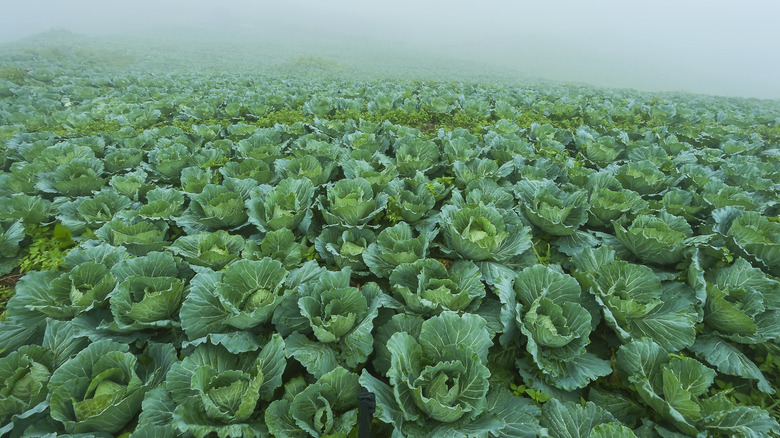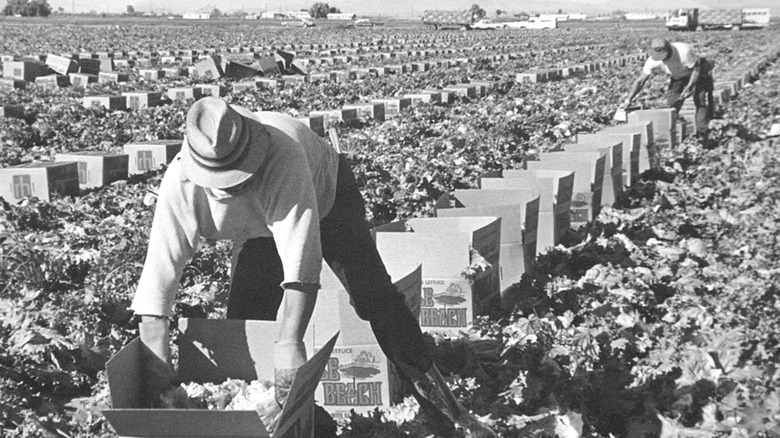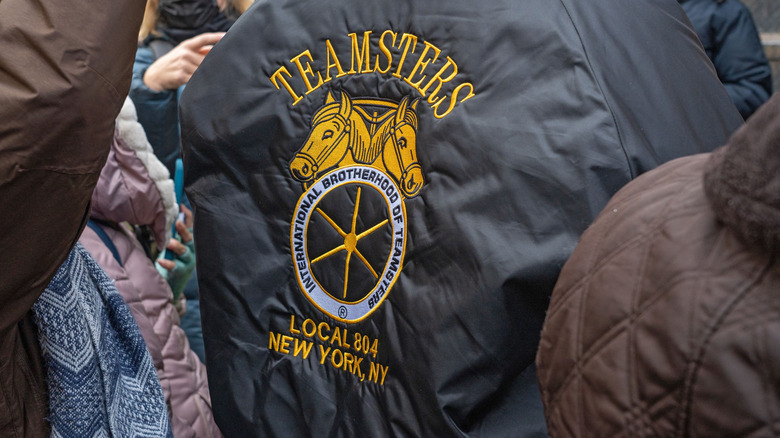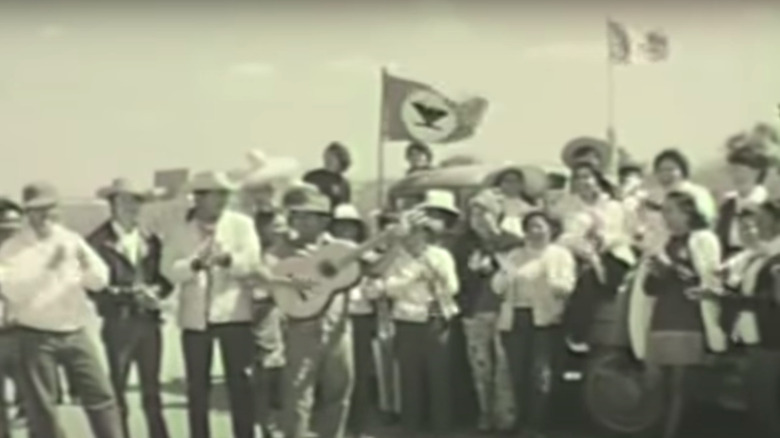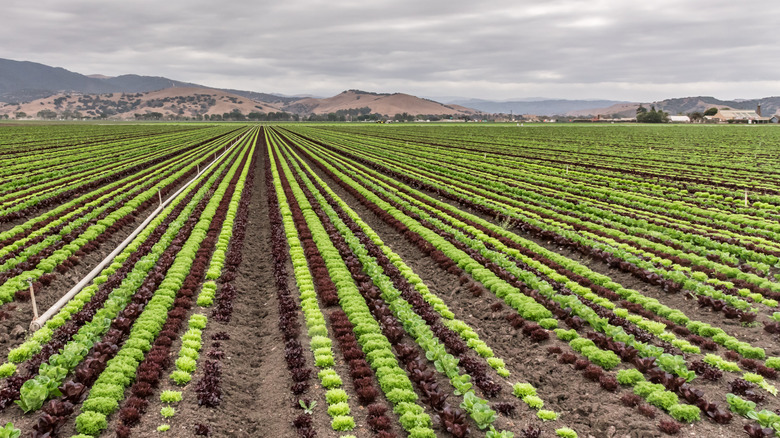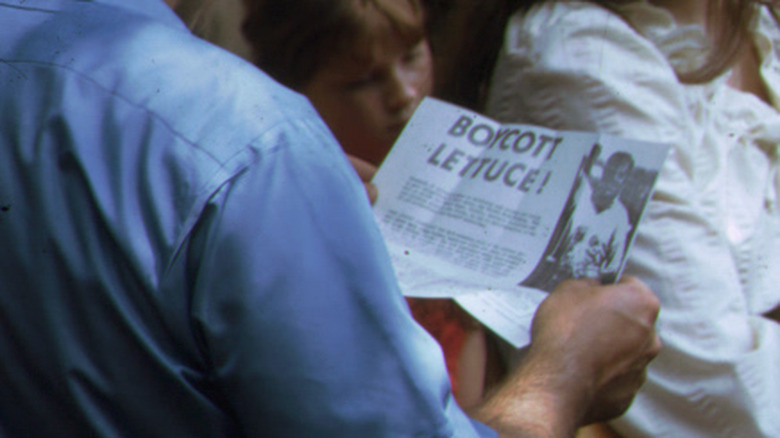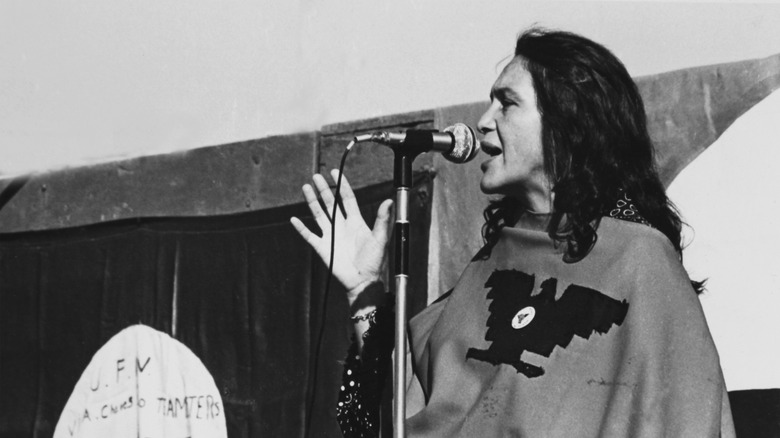Salad Bowl Strike: The Largest Farm Worker Strike In U.S. History
On the heels of a strike by grape workers, lettuce workers in California declared their own strike in 1970 as growers tried to pass off union contracts that happened to be most beneficial to employers. Because Salinas Valley was known as the "salad bowl of the nation," per Labor Leaders in America, the strike became known as the Salad Bowl Strike, but this wasn't the first time that lettuce workers in Salinas went on strike.
At the end of August 1934, Filipino lettuce cutters along with white packing shed workers went on strike in Salinas Valley. Led by the Filipino Labor Union, they demanded an improvement in working conditions as well as union recognition, according to People's World. Although the strike led to a hollow victory shadowed by vigilante gangs who burned down Filipino labor camps, it set the stage for lettuce workers fighting for their labor rights in Salinas Valley.
But in 1970, the situation wasn't a clean-cut case between unions and management. This time, there was another union in the mix who was interested in courting management.
The Teamsters are brought to Salinas
As lettuce growers in Salinas, California watched the impact of the United Farm Workers of America (UFW) during the Delano Grape Strike, they decided to get ahead of the situation by bringing in a union themselves. According to "Working People in California," edited by Daniel Cornford, the lettuce growers in the Salinas and Santa Maria valleys signed contracts with the Western Conference of Teamsters. However, the lettuce growers didn't consult any of their workers, an amalgamation of Black, Filipino, and Latinx workers, regarding who they wanted for representation.
And although the UFW repeatedly asked for workers to have secret ballot elections, this request was ignored and up to 200 contracts were signed with the Teamster union in the summer of 1970, according to "Straight Talk on the Lettuce Strike," posted at the University of California San Diego (UCSD). It's estimated that at least 170 lettuce growers signed "sweetheart" contracts, which are agreements reached without the consent of the workers, per "A Political Education Project Report" (also posted at UCSD).
Ultimately, this went against the 1967 agreement made between the Teamsters and the UFW, in which the Teamsters agreed to leave the unionizing of field workers to the UFW. But while the Teamsters insisted that workers preferred them over the UFW, according to a 1975 report by the Ann Arbor Sun (posted at Ann Arbor District Library), the Teamsters wouldn't even allow membership meetings, with one Teamster official claiming in 1975 that "l'm not sure how effective a union can be when it's composed of Mexican-Americans."
The Teamsters strike
When the Teamsters were initially brought in by the lettuce growers, they were being considered to be the exclusive bargaining representation for only the "driver-loaders, stitchers, and gluers." While these workers also have jobs in the field, they are the minority compared to the field workers, which also include row workers, pickers, and packers. According to the 1973 Hearing before the Subcommittee on Agricultural Labor, in the Santa Maria Valley, out of the 3,000 lettuce field workers, only 35 of them were driver-loaders, stitchers, or gluers.
After the Teamsters' initial demands weren't met, they called for a strike, which lasted from July 18-22. "Because the strike was honored by the numerous other Teamster members employed by the Growers, this concerted activity succeeded in substantially impairing the lettuce harvesting operations."
During the negotiations this time, the Teamsters insisted on being the exclusive bargaining agent for all field workers, despite the fact that they had neither spoken to the majority of the field workers, nor had those workers expressed a desire to be represented by the Teamsters. And on July 27, 1970, the growers and the Teamsters came to a formal written agreement of those terms in a five-year contract. According to Time Magazine, this gave the Teamsters "organizing jurisdiction over some 10,000 workers."
Voting to strike
As negotiations between the UFW and the Teamsters fell apart, the UFW voted to strike. The New York Times reports that on August 23, 1970, 3,000 members of the UFW voted to strike at least 27 vegetable ranches, targeting up to 50 growers who signed contracts with the Teamsters.
In the book "Trampling Out the Vintage: Cesar Chavez and the Two Souls of the United Farm Workers," Frank Bardacke writes that although there's debate about whether it was the Teamsters or the growers who first initiated the conversation about new contracts, "either way, it was a back-room deal, since no one had consulted the workers." A card count done among workers at InterHarvest on August 23, 1970 showed that a majority of field workers preferred to have the UFW as their union representation, according to the book "Promise Unfulfilled" by Philip L. Martin. One spokesman for InterHarvest was quoted as saying, "the Teamsters had our contract, but UFWOC had our workers," per Quintana & Friends" by John Gregory Dunne.
The largest farmworker strike in history
Out of roughly 10,000 lettuce workers, between 5,000 and 7,000 walked off the fields on August 23, 1970, making it the largest farmworker strike in American history, as of 2021. According to Dunne's "Quintana & Friends," lettuce growers felt the effect of the strike instantly. As the supply of lettuce dried up, wholesale prices more than doubled overnight.
Meanwhile, lettuce growers found themselves losing upwards of "$500,000 a day." It was this drastic loss in profits, combined with the UFW's organizational efforts, that convinced some of the lettuce growers to sign contracts with UFW. InterHarvest ended up signing a contract with UFW in the middle of September 1970, Time Magazine reports.
But some of the lettuce growers refused to concede to the UFW, and in September 1970, the Teamsters got an injunction (posted at Find Law) against the UFW that prohibited the UFW "from engaging in strikes, work stoppages or picketing at any of its agricultural operations." Although Dunne writes that the injunction was rejected based on insufficient evidence three weeks earlier, it was allowed by Judge Anthony Brazil on "virtually the same evidence" that was previously deemed insufficient.
Monthly Labor Review writes that the injunction was lifted in 1973 when the California Supreme Court found that the Teamsters had in fact entered into their agreement in 1970 on behalf of the workers "without determining whether the field workers supported the Teamsters."
Violence and arrests
After Judge Brazil made permanent the injunction against picketing, Cesar Estrada Chávez and Dolores Huerta, co-founders of the UFW, called off the picketers and declared instead a nationwide boycott against iceberg lettuce not grown by UFW workers. Many UFW supporters were arrested and filled up the "jail and the justice and the municipal courts," according to "Voting Rights Act: Evidence of Continued Need" from 2006.
According to a Hearing before the Subcommittee on the Constitution of the Committee on the Judiciary, after Bud Antle also got an injunction against the boycott, Chávez openly violated it in order to draw attention to the campaign. People's World writes that Chávez was jailed from December 10-23, 1970 for violating the injunction against the boycott.
There were also physical attacks on the UFW. Roger Bruns writes in "Cesar Chavez and the United Farm Workers Movement" that UFW striking workers were attacked by people with baseball bats and guns and often faced "cascades of rocks." At least six Teamster officials were found guilty of violating gun control laws for collecting firearms and explosives.
And there was at least one bombing incident against the UFW. On November 4, 1970, a bomb went off at the UFW union office in Hollister, California. According to PBS, "It is rumored to come from a rival union, competing to represent the farmworkers."
Impact of the Salad Bowl Strike
The strike finally ended on March 26, 1971, when the UFW and the Teamsters signed an agreement that once more affirmed the UFW's right to organize field workers. By the end of the strike, the UFW managed to negotiate over 200 contracts covering 70,000 workers that included pay raises, pesticide regulation, and the funding of a health and welfare fund, according to "Cesar Chavez and the United Farm Workers Movement."
Despite this victory, confrontation between the UFW and the Teamsters continued throughout the first half of the 1970s. The New York Times reports that during a strike in August 1973, hundreds were arrested as workers once more protested Teamster representation. In September 1973, the Teamsters came to an agreement once again with the UFW to "leave eventual representation of all field hands to the UFW," per The New York Times.
The real victory would come in 1975, when Governor of California Jerry Brown signed the California Agricultural Labor Relations Act, which gave all farmworkers the right to form or join unions. The law also defined unfair labor practices for farmworkers for the first time. This was especially significant because farmworkers were excluded from the 1935 National Labor Relations Act because "agriculture was different," according to "A comparison of California's ALRA and the Federal NLRA," posted at University of California Agriculture and Natural Resources.
